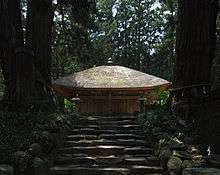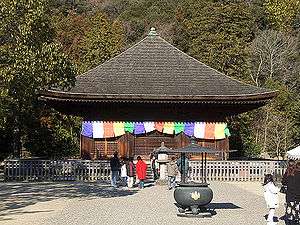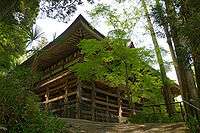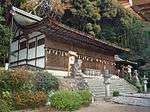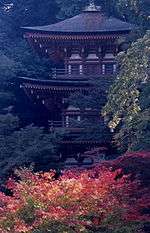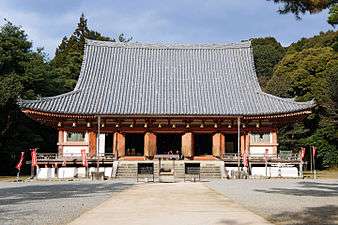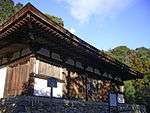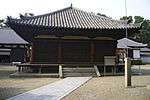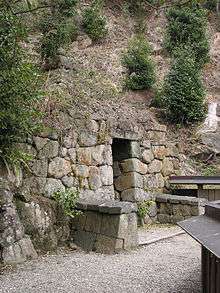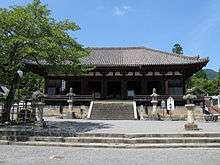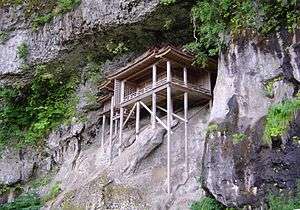List of Important Cultural Properties of Japan (Heian period: structures)
This list is of Japanese structures dating from the Heian period (794–1185) that have been designated Important Cultural Properties (including *National Treasures).[1][2]
Structures
Early Heian period
Seven surviving sites with the same number of component structures have been designated, including four National Treasures. Despite the transfer of the capital to Heian-kyō, due to losses in fires and wars, all are in Nara Prefecture, other than for a stone tō in Gunma Prefecture. Those at Tōdai-ji form part of the UNESCO World Heritage Site Historic Monuments of Ancient Nara;[3] that at Hōryū-ji is part of the World Heritage Site Buddhist Monuments in the Hōryū-ji Area.[4]
| Structure | Date | Municipality | Prefecture | Comments | Image | Coordinates | Ref. |
|---|---|---|---|---|---|---|---|
| Tōba 塔婆 tōba | 801 | Kiryū | Gunma | 36°25′44″N 139°13′14″E / 36.42900353°N 139.22055117°E | |||
| *Murō-ji Kondō 室生寺金堂 Murōji kondō | 794-929 | Uda | Nara |  | 34°32′15″N 136°02′28″E / 34.53756966°N 136.04113555°E | ||
| *Murō-ji Five-Storey Pagoda 室生寺五重塔 Murōji gojūnotō | 710-1184 | Uda | Nara |  | 34°32′18″N 136°02′25″E / 34.53828171°N 136.0403497°E | ||
| Tōdai-ji Kanjinsho Repository 東大寺勧進所経庫 Tōdaiji kanjinsho kyōko | 794-929 | Nara | Nara | 34°41′19″N 135°50′14″E / 34.6887352°N 135.83712764°E | |||
| Tōdai-ji Hokkedō Repository 東大寺法華堂経庫 Tōdaiji Hokkedō kyōko | 794-929 | Nara | Nara | | 34°41′17″N 135°50′39″E / 34.68813202°N 135.84407051°E | ||
| *Hōryū-ji Kōfūzō 法隆寺綱封蔵 Hōryūji kōfūzō | 794-929 | Ikaruga | Nara | 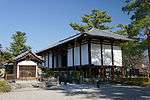 | 34°36′52″N 135°44′08″E / 34.61437166°N 135.735428°E | ||
| *Taima-dera West Pagoda 當麻寺西塔 Taimadera saitō | 794-929 | Katsuragi | Nara | 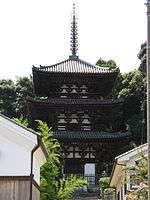 | 34°30′56″N 135°41′40″E / 34.5154578°N 135.69448418°E | ||
Middle Heian period
Five surviving sites with eight component structures have been designated, all but one of them National Treasures. The Phoenix Hall at Byōdō-in is designated as a single site with four component structures. The five-storey pagoda at Daigo-ji is the earliest structure within the current borders of the city of Kyoto. Both form part of the World Heritage Site Historic Monuments of Ancient Kyoto (Kyoto, Uji and Otsu Cities).[5]
| Structure | Date | Municipality | Prefecture | Comments | Image | Coordinates | Ref. |
|---|---|---|---|---|---|---|---|
| *Daigo-ji Five-Storey Pagoda 醍醐寺五重塔 Daigōji gojūnotō | 952 | Kyoto | Kyoto | 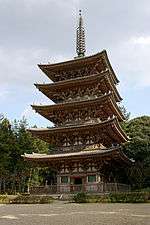 | 34°57′02″N 135°49′20″E / 34.95058043°N 135.8221424°E | ||
| *Byōdō-in Phoenix Hall (central hall) 平等院鳳凰堂 (中堂) Byōdōin hōōdō (chūdō) | 1053 | Uji | Kyoto | | 34°53′21″N 135°48′28″E / 34.88929886°N 135.80767417°E | ||
| *Byōdō-in Phoenix Hall (south wing corridor) 平等院鳳凰堂 (両翼廊 (南)) Byōdōin hōōdō (ryōyokurō (minami)) | 1053 | Uji | Kyoto |  | 34°53′22″N 135°48′28″E / 34.889473°N 135.807661°E | ||
| *Byōdō-in Phoenix Hall (north wing corridor) 平等院鳳凰堂 (両翼廊 (北)) Byōdōin hōōdō (ryōyokurō (kita)) | 1053 | Uji | Kyoto | | 34°53′21″N 135°48′28″E / 34.889119°N 135.807704°E | ||
| *Byōdō-in Phoenix Hall (tail corridor) 平等院鳳凰堂 (尾廊) Byōdōin hōōdō (birō) | 1053 | Uji | Kyoto |  | 34°53′21″N 135°48′27″E / 34.889266°N 135.807484°E | ||
| *Hōryū-ji Belfry 法隆寺鐘楼 Hōryūji shōrō | 1005-1020 | Ikaruga | Nara | 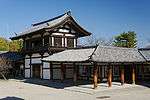 | 34°36′53″N 135°44′04″E / 34.614648°N 135.73457055°E | ||
| *Hōryū-ji Large Lecture Hall 法隆寺大講堂 Hōryūji daikōdō | 990 | Ikaruga | Nara |  | 34°36′53″N 135°44′03″E / 34.61474263°N 135.73416595°E | ||
| Thousand Buddha Treasure Tower 多宝千仏石幢 tahō senbutsu sekitō | 1084 | Dazaifu | Fukuoka | at the Kyushu National Museum | 33°31′06″N 130°32′19″E / 33.51828649°N 130.53848106°E | ||
Late Heian period
Thirty-five surviving sites with thirty-six component structures have been designated, including fourteen National Treasures. The earliest structures, other than four stone tō, outside Nara and Kyoto Prefectures date from the second half of the eleventh century or early twelfth century. Those at Chūson-ji form part of the World Heritage Site Hiraizumi – Temples, Gardens and Archaeological Sites Representing the Buddhist Pure Land.[6] Buraku-ji in Kōchi Prefecture, Shikoku, and Fuki-ji in Ōita Prefecture, Kyushu, contain the earliest wooden structures outside Honshu. The honden of Ujigami Jinja is the earliest wooden Shinto shrine building, while two stone examples from the city of Yamagata are the earliest torii.
See also
| Wikimedia Commons has media related to Architecture of Heian period. |
- Cultural Properties of Japan
- Japanese Buddhist architecture
- List of Important Cultural Properties of Japan (Nara period: structures)
- List of Important Cultural Properties of Japan (Kamakura period: structures)
References
- ↑ "Cultural Properties for Future Generations" (PDF). Agency for Cultural Affairs. March 2013. Retrieved 4 May 2014.
- ↑ "Database of National Cultural Properties: 国宝・重要文化財 (建造物): 平安" (in Japanese). Agency for Cultural Affairs. Retrieved 4 May 2014.
- ↑ "Historic Monuments of Ancient Nara". UNESCO. Retrieved 4 May 2014.
- ↑ "Buddhist Monuments in the Horyu-ji Area". UNESCO. Retrieved 4 May 2014.
- ↑ "Historic Monuments of Ancient Kyoto (Kyoto, Uji and Otsu Cities)". UNESCO. Retrieved 4 May 2014.
- ↑ "Hiraizumi – Temples, Gardens and Archaeological Sites Representing the Buddhist Pure Land". UNESCO. Retrieved 4 May 2014.
.jpg)
